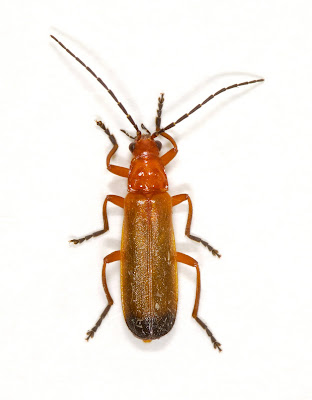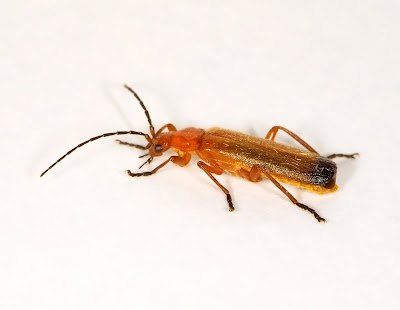Darkness falls on the nearby Kilpatrick hills, and though the sky burns vivid orange-red, the air is humid and the vegetation still moist from recent heavy rainfall. Humid, windless nights like this are best for trapping nocturnal insects.
A Gallery of July Beetles:
Beetles are amongst the most frequent non-moth visitors to fluorescent lighting (which attracts far more insects than incandescent light bulbs due to the higher ultraviolet ouput). Other common nocturnal visitors are midges, crane flies and caddis flies.
Beetles tend to be very restless, rarely staying still for even a second, which makes them difficult to photograph: my solution is to place them inside a white plastic bowl which is too smooth for them to easily climb up and stalls them long enough to take photos.
The first of our usual suspects is a beetle whose varied talents include using its head as a spade, eating poo and singing!
Aphodius rufipes (Dung Beetle - family Scarabaeidae)
 Aphodius rufipes - showing the (normally hidden) membraneous hindwings
Aphodius rufipes - showing the (normally hidden) membraneous hindwings Aphodius rufipes
Aphodius rufipes Aphodius rufipes
Aphodius rufipes Aphodius rufipes
Aphodius rufipesA wide shovel-shaped head, cylindrical body, small antennnae, and claw-like extensions on the tibia of the front legs, are all adaptations to a burrowing lifestyle.Both adults and larvae spend most of their lives feeding and burrowing in the dung of herbivores.
The club-shaped antennae are composed of lamellae which can be compressed into a ball or fanned out (in order to detect odours).
When the adult dung beetles arrive at a fresh cow pat, the males quickly set about courting the females - producing complex songs using their abdomino-alary stridulatory organs (which means they produce sounds by rubbing their wings against their abdomens).
Only the males sing, although the females possess identical stridulatory organs and have the ability to produce disturbance sounds when threatened.
Each song lasts from 10 to 20 minutes and is composed of a series of syllables produced in pulses, with each Aphodius species having its own unique song.
More info on the singing of Aphodius dung beetles can be found here: Vibratory Communication in Dung Beetles (Scarabaeidae, Coleoptera) by Julia Kasper & Petra Hirschberger, chapter 31 of Insect Sounds and Communication - Physiology, Behaviour, Ecology and Evolution (CRC Press, 2006).
Otiorhynchus porcatus (Weevil - family Curculionidae)
 Otiorhynchus porcatus
Otiorhynchus porcatus Otiorhynchus porcatus
Otiorhynchus porcatus Otiorhynchus porcatus
Otiorhynchus porcatusOtiorhynchus weevils have fused elytra (wing cases) which renders them completely flightless: this individual still managed to make an appearance indoors - I imagine its fast marching gait could traverse almost any terrain!
The nocturnal adults feed upon the foliage of a variety of plants, whilst the larvae feed underground on the roots.
This is one of the easier Otiorhynchus to identify - no other species has such deeply ridged, boxy-looking elytra.
Rhagonycha fulva (Soldier Beetle - family Cantharidae)
 Rhagonycha fulva
Rhagonycha fulva Rhagonycha fulva
Rhagonycha fulva Rhagonycha fulva
Rhagonycha fulva
Soldier beetles are a classic example of aposematism (when an organism is both brightly coloured and distasteful to predators - predators learn to avoid them) and produce bitter-tasting secretions from their prothoracic and abdominal glands.
This common species is mostly diurnal and congregates in large numbers on the flowerheads of thistles and umbellifers, where it feeds on flower pollen, nectar and smaller insects. The larvae are ground-dwelling and prey solely on other invertebrates.
These beetles often seen in mating pairs as they have a prolonged copulation - also known as mate-guarding - in which the males prevent females from mating with competitors.
Soldier beetles have soft, leathery elytra due to the larger amount of time spent air-borne than most beetles.
Identifying Soldier Beetles:
Rhagonycha fulva is easily identified by the testaceous (brick-red) colouration of the head, pronotum, legs and wing cases (the latter are black tipped). The antennae, mouthparts and tarsi (feet) are black.
For other species, there is a handy identification key available here (PDF document):
Cantharidae - Key to the Adults of the British Species (Original keys by Mike Fitton, 1973. Additions & ammendments by Brian Eversham, 2006).







No comments:
Post a Comment